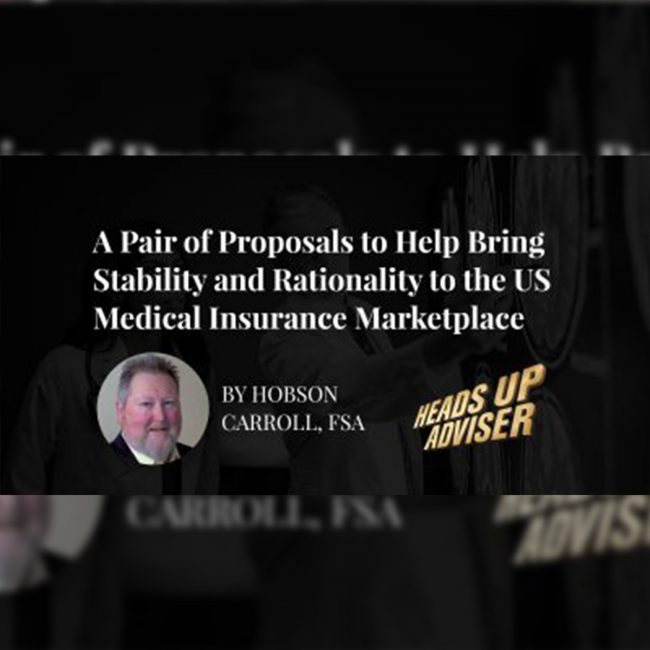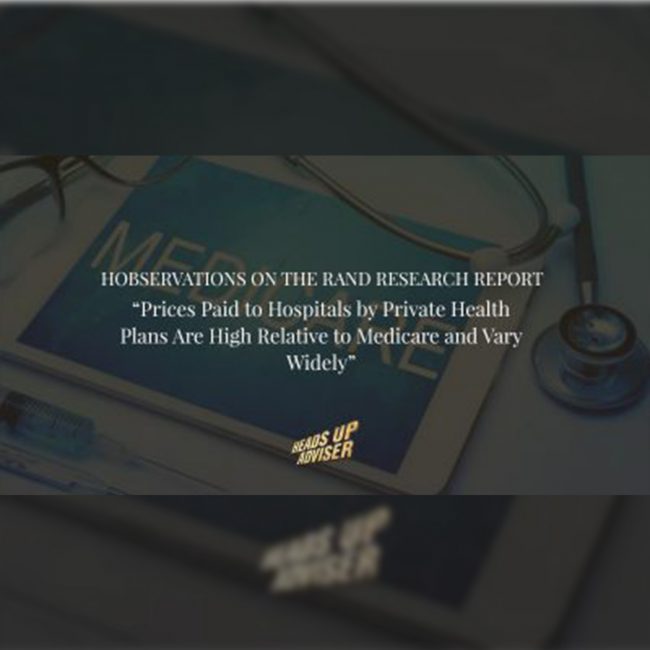Hobservations A Pair of Proposals to Help Bring Stability and Rationality to the US Medical Insurance Marketplace
Hobservations: A Pair of Proposals to Help Bring Stability and Rationality to the US Medical Insurance Marketplace

Hobson Carroll, FSA, MAAA, President, MedRisk Actuarial Services, Inc., has served the self-funded health community for four decades offering valuable actuarial services. Hobson's approaches are unorthodox and creative. His thinking leads the self-funded health arena to improve and recheck our bearings.
Hobson Carroll Proposal 1 - A National Public/Private Purchasing Cooperative for High Cost/Special Needs Drugs
Hobson Carroll, FSA, MAAA, President, MedRisk Actuarial Services, Inc., has served the self-funded health community for four decades offering valuable actuarial services. Hobson's approaches are unorthodox and creative.
Insurance is the way we handle newly occurring, previously unknown-contingency events that have financial consequences. In this country, it is also the way we have chosen to finance the bulk of preventive, primary, and intermediate acute care services and what I will call health “benefits,” if not health “insurance.” It is also the way we expect the system to provide initial financial support for new “ongoing” care requirements, and what, after the initial contract year of exposure, becomes the population with ongoing high cost chronic status discussed above. This is all in addition to the majority use of true insurance, that being the intermediate to high cost, but acute, non-recurring incident or episodes of care that were not previously expected, and which have little expected cost to follow.
While we can debate whether the insurance system should cover basic and preventive care (health benefits), it is pretty much a moot point because it is what we are already doing by tradition, by law, and by regulation. I believe it is fair to expect the private risk market to handle the initial onset of previously unknown, random occurring events that make up the true element of health insurance. It is, however, quite unfair to expect either the sponsoring organization (usually an employer sponsored plan, whether carrier-insured or employer-insured), or their private risk partners (direct carriers, stop-loss carriers, and reinsurers standing in whatever order behind initial risk-takers) to be required to provide non-risk based financing of conditions and treatments that society has deemed as a right for persons to receive and to have payment covered by someone other than themselves.
With that background, I should like to propose two initiatives that I believe would significantly improve the financing, and therefore to at least some extent the delivery, of the right kind of medical care for the ongoing chronic condition population.
Proposal One – A National Public/Private Purchasing Cooperative for High Cost/Special Needs Drugs
The National Public/Private Purchasing Cooperative (NPC) would be run on a cost-plus basis with expenses (which should be minimal) added to the prices established via the negotiation with Pharma and passed on via the resulting “national, single, non-discriminatory” price for each of the drugs that will be handled through the NPC schedule/formulary. Essentially, the NPC will function on the “market” side as a single source wholesaler to all purchasers in the country – government programs, traditional PBM/private market clients, insurers, etc. It will provide a single pricing structure to all payers without differentiation and will be the only legal source in the nation for purchasing the drugs that are on the list.
Having a properly negotiated, single national price for the types of drugs that fall into the high cost category will prevent the “squeeze over” cost shifting on price to take place and allow for a more properly managed total risk cost for these items. The net cost to the nation overall should also be reduced as a world equilibrium price is closer at hand, rather than the multiple “tier” pricing that has existed with the US market overpaying for the benefit of the world. Utilization/frequency use of these drug therapies and their impact on insuring entities is address more fully in the second proposal.
Hobson Carroll Proposal 2 - A National Mandatory Special Condition Reinsurance Cooperative
Hobson Carroll, FSA, MAAA, President, MedRisk Actuarial Services, Inc., has served the self-funded health community for four decades offering valuable actuarial services. Hobson's approaches are unorthodox and creative.
When a medical event arises for a person on a basis that was previously unknown/unexpected, that is a contingency that existing reinsurance/stop-loss markets are dynamic and robust enough to absorb for some “reasonable” amount of time following the diagnosis/start of such occurrence. However, the nature of our commercial reinsurance and stop-loss contracts is to tie everything to the contract period and relate liability solely to services/products provided during that defined time.
- That is, there are no occurrence/per-cause based type contracts of reinsurance or stop-loss protection, such as exists in, say, Worker’s Compensation, where the liability telescopes indefinitely from the event/accident date (at least for the most part).
The principles for design of such a program require certain basic elements. These include, but are not necessarily limited to:
- Well-defined terms for coverage, though with flexibility for appropriate change based on medical treatment evolution – who, what, when, how much, etc.
- Mandatory participation by all players.
- Fair and reasonable premium/cost construction.
- Mandatory for all “primary risk-taking” entities. No waivers.
- Initial coverage design is defined.
- Cost is actuarially based.
- The program self-adjusts with experience.
- Authority to assess to offset deficits.
- Reinsured Claimants (entities with persons with ongoing claims) incur an ongoing annual co-pay and annual maximum cost cap.
It is important that the initial estimates for premium rates be conservative to avoid such early assessments as it should be easier to adjust future premiums downwards than make up for deficits. This is an important and potentially challenging process to work through, but I believe the industry has the capacity to price closely the initial coverage once the definitions of that coverage are finalized. In addition to ongoing premium charges, entities with persons receiving active reinsurance protection (i.e., are being reimbursed ongoing claim amounts) from the facility will also contribute via a coinsurance, anticipated to be 10% up to a dollar cap per primary entity contract period, to maintain interest, and to offset some of the general program cost with a claimant specific contribution.
At this point, I will describe an example of how the reinsurance protection of this national facility might work in order to address the ongoing “financial” risk inherent in certain high cost, ongoing/chronic condition claimants. It is important to consider the concept of “status” as well as more traditional externally determined factors (such as a time period, or a dollar amount being reached) in both the establishment of whether a beneficiary covered by a primary insurer may be considered for coverage by the facility, i.e., “qualified,” and then to be in an “active” reimbursement category after meeting other contingent requirements for coverage.
For the purposes of an analogy, think “disability” insurance, where there is the primary requirement that an insured first be “disabled,” which is a form of status. Then, usually a time deductible (elimination period) must be met before benefits will actually become payable. However, once that time deductible is met, the person must continue to be in the status of “disabled” (contract definition) in order to actually activate the benefits payable and must stay in that status in order to continue to be paid.
Proposed Facility is to Pool & Fund "Ongoing, Known" Claims
An Unknown Contingency Becomes a Known Contingency
Once this “deductible” is met by the primary insurer (who may have other coverage, such as stop-loss protection if it is a self-insured entity, and which can respond to that first $250,000 layer), and the conditional status continues, then the claimant becomes covered by the reinsurance facility for 90% of expenses from that point on, subject to a maximum of $100,000 per underlying entity contract year applying to the 10% coinsurance for which they are responsible. That is, the maximum, in this example, that the primary entity would have to pay of the applicable claims would be 10% subject to a $100,000 cap for each contract period after reinsurance benefits become payable. I am suggesting this limitation because I believe it is not unreasonable to suggest that the primary insuring entity can budget and handle such an amount given the 10% share it represents, and it helps defray a portion of the ongoing claims cost of the facility itself without being onerous. Obviously, all these dollar and time parameters are variable to the final form of the program.
Conclusion
Remember that the purpose of this facility is to pool ongoing, known contingency, financial burdens that exist now with the expectation that the primary insurer and/or their reinsurance/stop-loss partners should be required to shoulder such randomly distributed situations, and not replace true unknown contingency financial risk management tools. The existing reinsurance and stop-loss market does quite well in providing protection to primary risk entities for this type of true insurance risk.
For a weekly dose of inspiration for healthcare brokers by healthcare brokers, subscribe to our blog.

Stay connected and inspired







